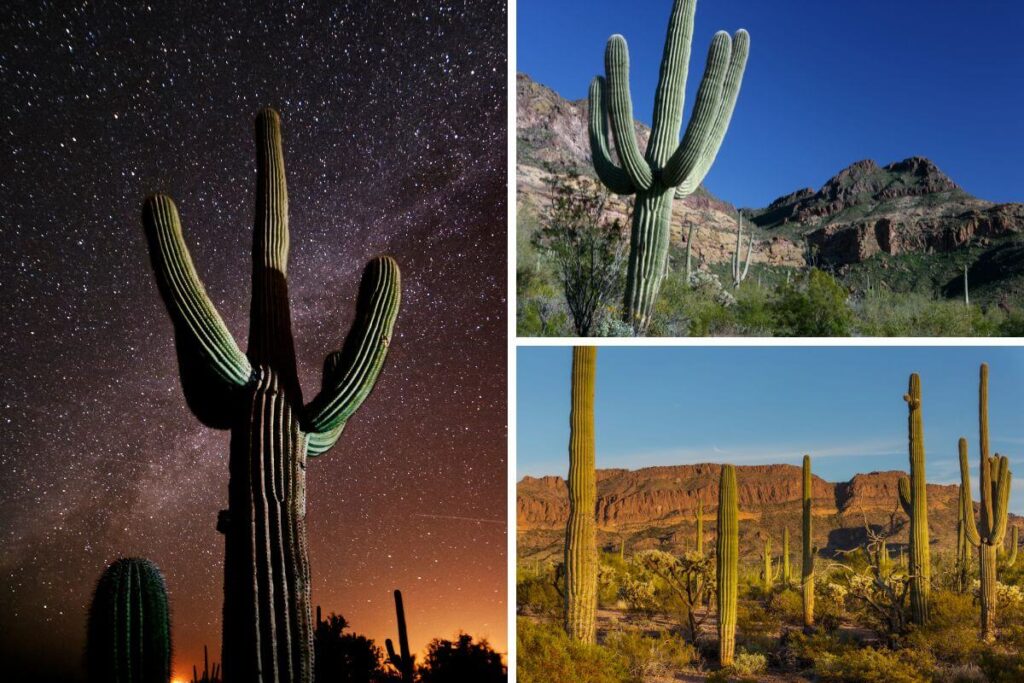
Have you ever wondered what the life of a cactus is like? No, I’m not talking about those small pots you have in your living room, but rather the giants that inhabit the deserts of the southwestern United States and northern Mexico. I’m talking about the saguaro cactus, an incredible plant that has much to teach us about adaptation, survival, and beauty. In this article, I will share with you five interesting facts about the saguaro cactus, ranging from its origin to its ecological significance. Let’s go ?
1. The saguaro cactus is the largest cactus in the world
The saguaro cactus (Carnegiea gigantea) is a species native to the Sonoran Desert, which spans parts of Arizona, California, and Mexico. It is known for its iconic appearance, featuring a tall, branched trunk and candelabra-shaped arms. The saguaro can grow up to 15 meters in height and live for over 150 years. It is considered the largest cactus in the world, surpassing in size other columnar cactus species found in South America.
2. The saguaro cactus has a very beautiful and fragrant flower
The saguaro cactus has a very beautiful and fragrant flower, considered the official flower of the state of Arizona. The saguaro flower is approximately 8 centimeters in diameter, with creamy white petals and a yellow center filled with stamens. The saguaro flower opens at night and lasts until midday the following day. It is pollinated by bats, bees, birds, and insects, attracted by its sweet nectar and pleasant fragrance. Each saguaro flower blooms only once, but the plant can produce hundreds of flowers during the spring and summer.
See also:
3. The saguaro cactus is a home for many animals
The saguaro cactus serves as a home for many animals that benefit from its shade, water, food, and protection. The saguaro has a woody skeleton that supports fleshy, succulent tissue capable of storing up to 800 liters of water. This water is crucial for the survival of desert animals, which may pierce the cactus to drink or cool down. Additionally, the saguaro produces fleshy, red fruits that are edible and nutritious for various species of birds, mammals, and reptiles. The saguaro also provides shelter for animals, which may create holes in its trunk or arms to build nests or dens. Among the animals that inhabit the saguaro are the Gila woodpecker, crow, opossum, coyote, lizard, and owl.
4. The saguaro cactus relies on other plants to grow
The saguaro cactus depends on other plants to grow, as it cannot establish itself independently in the harsh desert environment. The saguaro requires a nurse plant, which is a tree or shrub that provides shade, moisture, nutrients, and protection for its seed to germinate and develop. Common nurse plants include palo verde, ironwood, and mesquite, which are native species in the Sonoran Desert. The saguaro grows under the canopy of these plants, which reduce temperature, evaporation, radiation, and wind while enhancing soil fertility. It can take up to 10 years for the saguaro to reach a height of 20 to 25 centimeters and up to 75 years to start producing arms. Over time, the saguaro may outgrow its nurse plant in size and compete with it for resources, ultimately leading to the nurse plant’s demise. This is an example of an ecological relationship called amensalism, where one species is harmed, and the other is not affected.
5. Cultural and Historical Value
The saguaro cactus holds cultural and historical significance as it is a symbol of identity and tradition for the indigenous peoples inhabiting the Sonoran Desert. The saguaro is revered by the Tohono O’odham Indians, who consider it a sacred being and an ancestor. They use the saguaro for medicinal, culinary, artisanal, and religious purposes. Remedies are made from the flowers, fruits, thorns, and sap of the cactus, each possessing healing properties for various ailments. Wine, jam, syrup, flour, and bread are crafted from the saguaro fruits, harvested in an annual ceremony called Ha:San Bak, which celebrates the beginning of the new year and the arrival of the rains. The Tohono O’odham also create baskets, musical instruments, tools, and weapons from the woody skeleton of the saguaro, known for its resilience and durability. The saguaro plays a crucial role in the art, literature, music, and folklore of desert communities, expressing their admiration and respect for this extraordinary plant.
Conclusion
In summary, the saguaro cactus is a fascinating plant that demonstrates nature’s ability to adapt and thrive in challenging conditions. The saguaro is the largest cactus in the world, boasting a beautiful and fragrant flower. It serves as a home for numerous animals, relies on other plants for growth, and holds cultural and historical value. Therefore, the saguaro stands as one of the wonders of the desert, deserving of recognition and preservation.